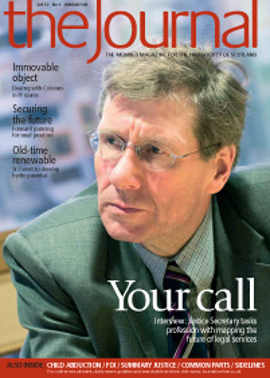Lay justice reborn

The Smarter Justice, Safer Communities: Summary Justice Reform – Next Steps document, published in March 2005 by the then Scottish Executive, announced the intention to retain a lay justice element in the summary court structure. The previous year, in the McInnes Committee’s report, a majority of committee members had supported the abolition of lay justice and the establishment of an entirely professional judiciary. Two members disagreed and published a note of dissent. After consulting on the report the Scottish Executive took the view that the existence of a lay judiciary was a powerful expression of the partnership between professionals and communities, and an important example of community engagement in the justice system.
Creation of the JP court
The Executive’s proposal, therefore, was that there should continue to be two tiers of summary courts, and that the second tier should continue to have a lay judiciary. In arriving at that conclusion, however, account had to be taken of other aspects of the reform programme. The increased use of direct measures, it was anticipated, would take business out of the district court, creating capacity which would need to be used if the sheriff court were to operate more effectively. This in turn would mean the lower court dealing with a different case profile comprising more serious cases. And the Next Steps document emphasised the importance of more effective court hearings, and the critical role of the judiciary in delivering these.
Against that background it was recognised that the status quo was not an option. However, the Executive was of the view that the necessary functions of the lower tier could be fulfilled by improvements to lay justice, rather than its abolition. The need to review and where appropriate improve the recruitment, training and appraisal of the lay judiciary was appreciated; and in recognition of the improvement the Executive resolved that the lay court would be recreated.
Benefits of unification
Having decided to retain a two-tier system, the Executive also had to consider the recommendation of the McInnes Committee that the administration of both tiers should be “unified” under one service provider, rather than having each of the lower courts provided by the relevant local authority.
The McInnes Committee identified a number of issues with the present structure of the summary courts. These included variations in training for justices and legal assessors, the level of investment in district courts, and a less than optimal use of the court estate. After consultation, the Executive accepted the recommendation to unify.
The purpose, therefore, of the structural changes is that summary courts will be unified under the administration of Scottish Court Services (SCS). Unification will take place on a sheriffdom by sheriffdom basis, starting with Lothian & Borders in March 2008, with Grampian, Highland & Islands due to follow by summer 2008.
It is intended that this will deliver a number of benefits. Together with the plans for lay justice, unification will ensure a more consistent level of training and of other services, better use of the highly specialised court estate, greater simplicity and accountability, and a more integrated service.
It should also ensure better use of IT. Ultimately all courts will use an integrated IT system, rather than IT use being fragmented and inconsistent across the courts. And it follows that there will be more consistency in the benefits to be realised from investment across the court service.
Unification on a sheriffdom by sheriffdom basis, rather than a “big bang”, will enable change to be managed and lessons to be learned, and will also underpin the message that while consistency is desirable, so is the ability of individual areas to deliver appropriate solutions for the communities they serve.
The Act’s provisions
The Criminal Proceedings etc (Reform) (Scotland) Act 2007, accordingly, makes a number of provisions designed to effect these changes. The Act provides for the abolition of district courts (s 64), with the explicit purpose of removing them entirely. The Act also creates a duty on the Scottish Ministers to secure the adequate and efficient provision of summary courts, and a power to establish justice of the peace courts, known as JP courts. They are to be established with reference to sheriff court districts, and there must be at least one JP court in each district unless Scottish Ministers decide that a JP court is unnecessary (s 59). The obligations on local authorities in connection with district courts are removed.
The sheriff principal is given responsibility for the administration of JP courts in his/her sheriffdom (s 61). And a JP court will have jurisdiction over offences committed within both its sheriff court district and any other district in the same sheriffdom. In addition a JP or stipendiary magistrate can sit in any court within the sheriffdom for which s/he was appointed (s 62).
The powers and competence of the JP court are the same as for the district court (s 63). Scottish Ministers are given the power (in s 46) to employ secondary legislation to increase the sentencing power of the JP court, to a maximum of six months’ imprisonment and a fine at level 5. No immediate increase is provided for in the Act, and this section is not being commenced for now. However, legislation has been enacted at the UK Parliament which will allow JP courts, in road traffic cases, to impose disqualification from driving in addition to their existing powers to disqualify under totting up.
JPs will be appointed for renewable five-year terms, but will cease to hold office from the age of 70 (ss 67 and 70). Provision is made for the removal, in certain defined circumstances, of JPs from office (s 71) and for disqualification on sequestration or bankruptcy (s 73).
It is worth noting that stipendiary magistrates are retained, and full time stipendiary magistrates are not subject to fixed five year terms of office (s 74).
Improving performance
As was seen in the first article in this series, an important part of the summary justice reform programme is the increased use of direct measures (alternatives to prosecution). Notwithstanding that, the Crown is committed to, at least, maintaining current business levels in the lower tier of courts. It is therefore important that those courts retain the confidence of all court users. Recognising that, the Act makes provision for the training and appraisal of JPs (s 69). By now, almost all of the current cohort of JPs have had training specifically designed to enable the courts to deal with the implications of the reform programme. And appraisal will take place in due course, with the intention of maintaining a consistent level of performance.
These changes build on the accepted strengths of lay justice while making sure that the summary court system remains fit for purpose in the 21st century. Unification will deliver benefits in efficiency, and at the same time the creation of the JP court, with improved training and the introduction of appraisal, will enable the quality of lay justice to keep pace with the demands being made on the summary courts after implementation of the summary justice reform programme.
The Act is being commenced in phases. Transitional and savings provisions have been made in the commencement orders. Further details can be found at www.scotland.gov.uk/Topics/Justice/criminal/criminalprocedure/19008/PlansForReform.
David A Dickson is a procurator fiscal depute on part-time secondment to the Scottish Government
In this issue
- More than just a new year
- Let youth have its say
- "You sort it out"
- A Colossus in the room
- ARTL cometh
- Letter from South Africa
- Lay justice reborn
- Power flows
- Year of the Commission
- Down to brass tacks
- Step up for Brussels office
- Small is doable
- Watching their diets
- 2008: let the fun commence
- Act going to plan
- Preferential treatment?
- Giving it the works
- Scottish Solicitors' Discipline Tribunal
- "Charity begins at home" - but does it?
- Website reviews
- Book reviews
- Freedom has its boundaries
- Pointing which way?
- There may be trouble ahead






